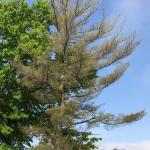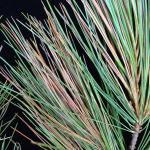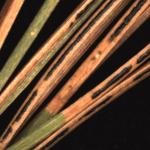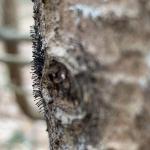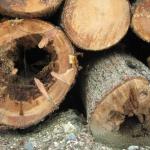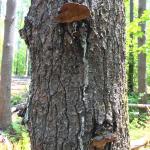Dieback of Eastern White Pine
Dieback of Eastern White Pine (Pinus strobus): Pathogens, Pests and a Changing Climate
Summary
Eastern white pine (Pinus strobus) is one of the most economically valuable and ecologically important forest trees in the northeast. It is also an abundant landscape tree with numerous cultivars available through the nursery trade. In recent years, white pines in the region have exhibited symptoms of decline, which include: yellowing/browning needles, premature needle shedding, thinning canopies, undersized shoots and needles, resinosis, branch dieback and death. Widespread health issues for white pine first developed in approximately 2009. In the ten years since these problems became apparent, a great deal has been learned and it’s now known that multiple fungal pathogens, an insect pest and a changing climate are responsible. First and most importantly, white pine needle disease (WPND) is primarily responsible for the symptoms that many trees exhibit and is caused by several fungal pathogens. Branch and trunk cankering, caused by Caliciopsis canker, is also as an important component of the decline complex although disease severity varies by region. Most recently, the eastern white pine bast scale has been identified as an important predisposing agent that helps facilitate Caliciopsis canker. What is particularly interesting about the pathogens and insect pest responsible for white pine decline is that each is known or believed to be native in eastern North America. The widespread distribution of symptomatic trees and lack of a non-native pathogen or insect lead researchers to investigate the role of environmental conditions, which have been altered by a changing climate. What they found was that an increase in temperature and precipitation from May through July has helped to fuel the WPND epidemic. It is believed that the issues facing eastern white pine will only continue but management options do exist to help improve the health and vigor of stressed white pines.
White Pine Needle Disease
WPND is primarily caused by four fungal pathogens: Lecanosticta acicola (formerly Mycosphaerella dearnesii), Septorioides strobi, Bifusella linearis and Lophophacidium dooksii (formerly Canavirgella banfieldii). However, several other needle pathogens can also be found from stressed trees. Symptoms of WPND largely depend on the pathogen responsible, but their actions all result in premature needle shedding. It’s important to note that needle blight pathogens rarely kill trees by themselves. Yet, the annual cycle of infection and loss of older foliage creates a chronic stress that can severely weaken trees and exhaust stored resources. Of the fungi listed above, Lecanosticta and Septorioides are the most commonly encountered on both landscape and forest white pines, but the remaining fungi are locally abundant throughout their range.
WPND is favored by wet weather in May, June and July, when white pines are flushing new growth, followed by dry late season weather. Studies have shown that a changing climate in the northeast has contributed to WPND by creating conditions more conducive for disease development and spread. In particular, the region is experiencing more frequent rainfall events from May through July. The frequency of events does not necessarily mean an increase in total rainfall accumulation. Almost any rainfall event appears sufficient to induce spore production, dispersal and subsequent germination on newly developing needles. At the same time, overall precipitation has been increasing in the northeast during what is considered the cumulative growing season (April through September). Additionally, WPND is favored by high relative humidity at night and mild temperatures, conditions that are usually common in late spring and early summer throughout the northeast. The northeast has been experiencing an increase in average temperature during the cumulative growing season since the mid-20th century. The combined effects of increased temperature and precipitation have improved conditions for WPND pathogens. Spore dispersal primarily occurs from late May through August but the peak dispersal period occurs in mid-June in many locations. This peak spore dispersal period not only coincides with peak shedding of older, diseased needles but also with elongation of the current season’s needles. These young and immature needles are readily infected but will not show symptoms of WPND for many months. The long, latent period between infection and symptom development is common for many needle blight pathogens of conifers.
White pines suffering from severe cases of needle blight are compensating for the defoliation in several interesting ways. First, they are increasing their rates of photosynthesis in the remaining needles, meaning the limited number of needles they have left are working harder. Second, their water-use efficiency also increases. Lastly, diseased white pines are prioritizing carbon storage over annual growth. In a comparison of diseased and healthy white pines, researchers found that diseased trees exhibited higher rates of carbon storage relative to annual growth. Close inspection of white pines affected by WPND often reveals undersized shoots and stunted needles. Due to their limited ability to photosynthesize because of fewer needles, the trees are electing to “save” resources into storage as opposed to “spending” those resources on new growth. So while it may appear that the lack of growth indicates the trees are spiraling downward towards death, we now know the trees are prioritizing carbon storage to ensure they have resources for the future.
When needles are prematurely shed early in the growing season due to WPND, white pines not only have a reduced ability to photosynthesize, but they also lose foliar nitrogen that would have been retained prior to natural senescence. When foliage is naturally senescing as trees prepare for winter dormancy, trees will pull nitrogen out of the declining foliage, a process known as resorption. Research has shown that needles prematurely shed early in the growing season can have twice the amount of nitrogen present compared to needles naturally shed in autumn. Therefore, white pines may respond to nitrogen fertilization and anecdotally, some arborists have noted an improvement in vigor after fertilizing diseased white pines. It is also known that trees already in decline are more susceptible to WPND and suffer greater rates of defoliation. Therefore, it’s critical to limit additional and unnecessary stresses in both forest and landscape settings.
Caliciopsis Canker
Calciopsis canker, primarily caused by Caliciopsis pinea, is a well-known fungal pathogen of white pine, having been first reported in New York State in the late 1800s. Reference to Caliciopsis is common in older forest pathology literature but rarely as a destructive pathogen of concern. The fungus is capable of attacking additional pines and other conifers but is rarely observed. Branch and trunk cankers can appear smooth, depressed and reddish-brown in color. When they occur below the branch whorls, the bark may be especially rough and cracked. The most conspicuous symptom of infection is streaming resin (resinosis) on the trunk and branches. Signs of Caliciopsis include small, curved, black-colored stalks or spines that represent spore-bearing structures. These are often referred to as “eyelashes” given their resemblance. In the mid-1990s, the incidence and severity of Caliciopsis canker began to increase, especially in southern New Hampshire and western Maine. The disease appears to be most severe in both the northeast and southeast U.S. with scattered reports from the Upper Midwest. In forest settings, pole-sized trees in dense stands are most susceptible to the disease while in landscapes, trees in dense groves or screens are most at risk. Trees can harbor numerous cankers that degrade both vigor of the tree and the quality of the lumber. Regenerating saplings in the understory are regularly infected, which can result in mortality. Recently, it has been found that Caliciopsis is attacking stressed and weakened trees in association with feeding by the white pine bast scale.
White Pine Bast Scale
The white pine bast scale (WPBS; Matsucoccus macrocicatrices) is also native to the northeast but has never warranted any major attention from entomologists. The name refers to the tissues affected by the scale’s piercing and sucking mouthparts. Bast cells are a component of the phloem and contain fluids just beneath the outer bark. While other species in genus Matsucoccus are serious pests of pine, WPBS feeding results in almost no damage to infested white pines. Known from eastern Canada and New England for decades, the WPBS was first detected in the southern Appalachians in 2007 and has since been found throughout the southeast. While not an important pest of white pine by itself, the feeding sites are readily colonized by Caliciopsis, allowing the cankering pathogen to establish infections on susceptible white pines more easily. The link between the WPBS and Caliciopsis is now well documented and researchers believe that this facultative relationship has developed into a pest-pathogen complex. The WPBS is very small and difficult to detect in the field without the aid of a hand lens and, in many cases, someone with experience in identifying the scale. The second instar (cyst stage) is the most conspicuous. At this stage, the swollen cysts are shiny and black in color and can be found near branch whorls within cracks and underneath lichens. The WPBS scale can be found on saplings, pole-sized and mature white pines.
Wood-Rotting Pathogens
Native, wood-rotting fungal pathogens are also a contributor to decline and death of white pines in landscape and forest settings. For saplings and pole-sized trees, especially in dense understory settings, Armillaria readily causes root decay and death. Mature trees, however, are fairly resistant to Armillaria root disease due to their structural and chemical defenses. Brown cubical rot, caused by Phaeolus schweinitzii (known as the velvet top fungus), is likely more common and important than any other root and butt rot pathogen but historically has been very poorly studied. Trees may have significant infections but the decay is confined to the heartwood and there are no visible symptoms of the disease. Wood in advanced decay appears dark brown and readily breaks in cubical sections, hence the name brown cubical rot. The actions of brown rot fungi like Phaeolus result in dramatic reductions in bending strength in the affected areas of the trunk. As a result, structural failure due to infection is more likely than water starvation and parasitism of the phloem. Ephemeral mushrooms appear near the base of infected white pines from early August through September. The upper surface of the mushroom appears yellowish-brown with a distinctly yellow margin. Once exposed to near freezing temperatures the mushrooms become dark brown and less conspicuous. For mature white pines, red ring rot caused by Porodaedalea pini s.l. results in significant losses of timber in managed forests. The pathogen invades through branch stubs but the decay is typically confined to the heartwood. Symptoms of infection may be too nuanced to notice but "punk knots" may be visible on the trunk. These appear as swollen and bulging sections of the trunk and consist of masses of fungal tissue with wood and resin embedded under the bark. Annual to perennial conks produced by Porodaedalea are not reliable indicators of decay and tend to be uncommon on trees <100-years-old. As a result, the fungus is not often observed in landscape settings and may be cryptic in forest settings.
Management & Conclusions
Active management to combat the issues facing eastern white pine can be difficult due to their natural abundance and large size. Research has shown that thinning to create lower density stands of white pine promotes crown vigor, radial growth and reduces the severity of WPND. Heavier thinning operations had a more significant effect on the reduction of WPND. The same practice can be applied on a smaller-scale in landscape settings by thinning white pine groves or removing neighboring, less desirable trees in competition with white pine. Nitrogen fertilization may help trees restore vigor, especially for trees chronically stressed by WPND. Because stressed white pines are more susceptible to attack from other opportunistic pests and pathogens, eliminate unnecessary stresses in landscape settings. Fungicide application is often impractical for large trees or when many trees require treatment. However, focused applications on younger or specimen white pines can help to combat WPND and other opportunistic pathogens. What is clear is that the issues facing eastern white pine aren’t going away anytime soon.
A majority of the findings presented here were from studies conducted by the USDA Multistate Working Group (NE1601), which is focused on eastern white pine health and responses to environmental changes. Further reading can be found here: https://www.sciencedirect.com/journal/forest-ecology-and-management/vol/423/suppl/C.
